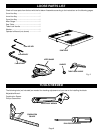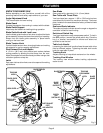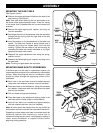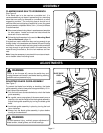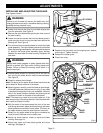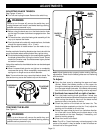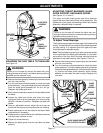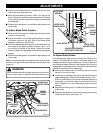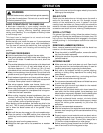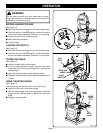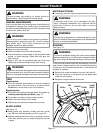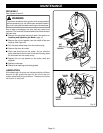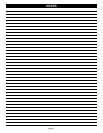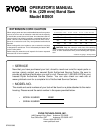
Page 16
OPERATION
■ Open front cover and turn the upper wheel by hand while
backing up the workpiece.
RELIEF CUTS
Relief cuts are made when an intricate curve (too small a
radius for the blade) is to be cut. Cut through a scrap
section of the workpiece to curve in pattern line then
carefully back the blade out. Several relief cuts should be
made for intricate curves before following the pattern line
as sections are cutoff of curve “relieving” blade pressure.
SCROLL CUTTING
For general type scroll cutting, follow the pattern lines by
pushing and turning the workpiece at the same time. Do
not try to turn the workpiece while engaged in the blade
without pushing it – the workpiece could bind or twist the
blade.
REMOVING JAMMED MATERIAL
Never remove jammed cutoff pieces until the blade has
come to a full and complete stop.
■ Place the switch in the OFF position, remove the switch
key from the switch assembly.
■ Unplug the saw from the power source before removing
jammed material.
AVOIDING INJURY
■ Make sure saw is level and does not rock. Saw should
always be on a firm, level surface with plenty of room for
handling and properly supporting the workpiece.
■ Bolt saw to the support surface to prevent slipping,
walking or sliding during operations like cutting long,
heavy boards.
■ Turn saw off, remove switch key, and unplug cord from
the power source before moving the saw.
■ Do not remove jammed cutoff pieces until blade has come
to a full and complete stop.
■ Choose the right size and style blade for the material
and type of cut you plan to do.
■ Make sure that the blade teeth point down toward the
saw table, that the blade guides, thrust bearings, and
blade tension are properly adjusted, that the blade guide
knob is tight, and that no parts have excessive play.
■ To avoid accidental blade contact, minimize blade
breakage, and provide maximum blade support, always
adjust the blade guide assembly to just clear the
workpiece.
■ Use only recommended accessories.
■ With the exception of the workpiece and related support
devises, clear everything off the saw table before turning
the saw on.
■ Properly support round materials such as dowel rods or
tubing because they have a tendency to roll during a cut
causing the blade to “bite”. To avoid this, always use a
“V” block or clamp workpiece to a miter gauge
■ Before removing loose pieces from the saw table, turn
saw off and wait for all moving parts to stop.
WARNING:
To avoid blade contact, adjust the blade guide assembly
to just clear the workpiece. Failure to do so could result
in serious personal injury.
BASIC OPERATION OF THE BAND SAW
A band saw is basically a “curve cutting” machine that
can also be used for straight-line cutting operations like
cross cutting, ripping, mitering, beveling, compound
cutting, and resawing. It is not capable of making inside
or non-through cuts.
This band saw is designed to cut wood and wood
composition products only.
Before starting a cut, watch the saw run. If you experience
excessive vibration or unusual noise, stop immediately.
Turn the saw off, remove the switch key, and unplug the
saw. Do not restart until locating and correcting the
problem.
CUTTING PROCEDURES
■ Hold the workpiece firmly against the saw table.
■ Use gentle pressure and both hands when feeding the
work into the blade
.
Do not force the work; allow the
blade to cut.
■ The smallest diameter circle that can be cut is determined
by blade width. A 1/4 in. (6 mm) wide blade will cut a
minimum diameter of 1-1/2 in. (38 mm); a 1/8 in. (3 mm)
wide blade will cut a minimum diameter of 1/2 in. (13 mm).
■ Keep your hands away from the blade. Do not hand hold
pieces so small your fingers will go under the blade guard.
■ Avoid awkward operations and hand positions where a
sudden slip could cause serious injury from contact with
the blade. Never place hands in blade path.
■ Use extra supports (tables, saw horses, blocks, etc.)
when cutting large, small or awkward workpieces.
■ Never use a person as a substitute for a table extension
or as additional support for a workpiece that is longer or
wider than the basic saw table.
■ When cutting irregularly shaped workpieces, plan your
work so it will not pinch the blade. For example, a piece
of molding must lay flat on the saw table. Workpieces
must not twist, rock or slip while being cut.
When backing up the workpiece, the blade may bind in the
kerf (cut). This is usually caused by sawdust clogging the
kerf or when the blade comes out of the guides. If this
happens:
■ Wait until the saw has come to a full and complete stop.
■ Place the switch in the OFF position then remove the
switch key from the switch assembly. Store key in a safe
place.
■ Unplug the saw from the power source.
■ Wedge the kerf open with a flat screwdriver or wooden
wedge.




